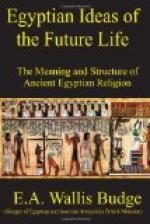Before we pass to the consideration of the manner in which the judgment is depicted upon the finest examples of the illustrated papyri, reference must be made to an interesting vignette in the papyri of Nebseni [Footnote: British Museum, No. 9900.] and Amen-neb. [Footnote 2: British Museum, No. 0964.] In both of these papyri we see a figure of the deceased himself being weighed in the balance against his own heart in the presence of the god Osiris. It seems probable that a belief was current at one time in ancient Egypt concerning the possibility of the body being weighed against the heart, with the view of finding out if the former had obeyed the dictates of the latter; be that as it may, however, it is quite certain that this remarkable variant of the vignette of Chapter 30B had some special meaning, and, as it occurs in two papyri which date from the XVIIIth dynasty, we are justified in assuming that it represents a belief belonging to a much older period. The judgment here depicted must, in any case, be different from that which forms such a striking scene in the later illustrated papyri of the XVIIIth and following dynasties.
We have now proved that the idea of the judgment of the dead was accepted in religious writings as early as the IVth dynasty, about B.C. 3600, but we have to wait nearly two thousand years before we find it in picture form. Certain scenes which are found in the Book of the Dead as vignettes accompanying certain texts or chapters, e.g., the Fields of Hetep, or the Elysian Fields, are exceedingly old, and are found on sarcophagi of the XIth and XIIth dynasties; but the earliest picture known of the Judgment Scene is not older than the XVIIIth dynasty. In the oldest Theban papyri of the Book of the Dead no Judgment Scene is forthcoming, and when we find it wanting in such authoritative documents as the Papyrus of Nebseni and that of Nu, [Footnote: British Museum, No. 10,477.] we must take it for granted that there was some reason for its omission. In the great illustrated papyri, in which, the Judgment Scene is given in full, it will be noticed that it comes at the beginning of the work, and that it is preceded by hymns and by a vignette. Thus, in the Papyrus of Ani, [Footnote: British Museum, No. 10,470.] we have a hymn to R[=a] followed by a vignette representing the sunrise, and a hymn to Osiris; and in the Papyrus of Hunefer, [Footnote 2: British Museum, No. 9901.] though the hymns are different, the arrangement is the same. We are justified, then, in assuming that the hymns and the Judgment Scene together formed an introductory section to the Book of the Dead, and it is possible that it indicates the existence of the belief, at least during the period of the greatest power of the priests of Amen, from B.C. 1700 to B.C. 800, that the judgment of the dead for the deeds done in the body preceded the admission of the dead into the kingdom of Osiris. As the hymns which accompany the Judgment Scene are fine examples of a high class of devotional compositions, a few translations from some of them are here given.




